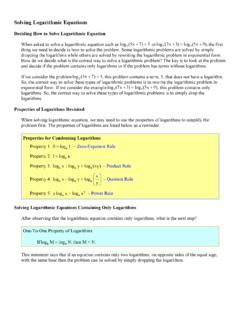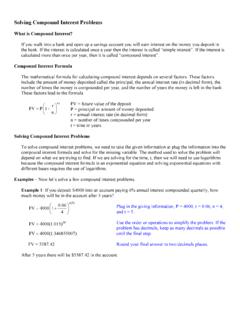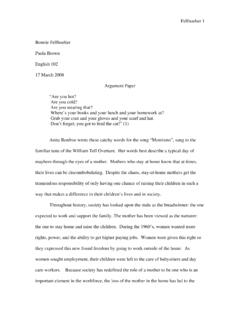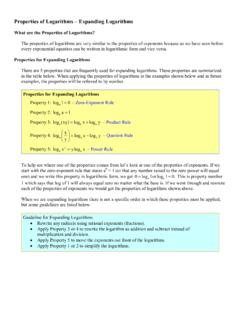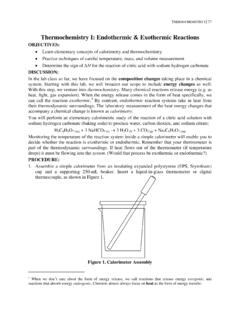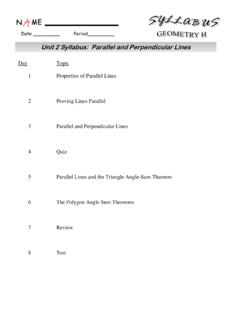Transcription of Find the Equation of a Line Parallel or Perpendicular to ...
1 Find the Equation of a line Parallel or Perpendicular to another line Notes Page 1 of 4 Find the Equation of a line Parallel or Perpendicular to another line As we have seen when finding the Equation of a line given two points, there are three steps required to find the answer. These three steps are: Step 1: Find the slope of the line . Step 2: Use the slope to find the y-intercept. Step 3: Use steps 1 and 2 to write the answer. In these examples we will continue to use the same three steps to find the answer, but we will not be given two points. You will be asked to find equations of line that are either Parallel or Perpendicular to a given line passing through a specific point.
2 So the first thing we need to do is remind ourselves about how we know if line are Parallel or Perpendicular from an algebraic point of view. Parallel Lines Two lines are Parallel if the have the same slope. Example 1: Find the slope of the line Parallel to the line 4x 5y = 12. To find the slope of this line we need to get the line into slope-intercept form (y = mx + b), which means we need to solve for y: The slope of the line 4x 5y = 12 is m = 4/5. Therefore, the slope of every line Parallel to this line would have to be m = 4/5. Perpendicular Lines Two lines are Perpendicular if.
3 another way of saying this is the slopes of the two lines must be negative reciprocals of each other. Example 2: Find the slope of the line Perpendicular to the line 6x 9y = 4. To find the slope of this line we need to get the line into slope-intercept form (y = mx + b), which means we need to solve for y:. The slope of the line 6x 9y = 4 is m = 2/3. Therefore, the slope of every line Perpendicular to this line would have to be m = 3/2 because ( 2/3)(3/2) = 1. Now let s look at some examples that use these ideas to find lines that are either Parallel or Perpendicular to a given line passing through a specific point.
4 Find the Equation of a line Parallel or Perpendicular to another line Notes Page 2 of 4 Example 3: Find the Equation of a line passing through the point ( 6, 5) Parallel to the line 3x 5y = 9. Step 1: Find the slope of the line . To find the slope of the given line we need to get the line into slope-intercept form (y = mx + b), which means we need to solve for y: The slope of the line 3x 5y = 9 is m = 3/5. Therefore, the slope of the line Parallel to this line would have to be m = 3/5. Note: The y-intercept for the line 3x 5y = 9 is b = 9/5. The y-intercept has nothing to do with the final answer to the questions and can be ignored in every problem.
5 All you need to move forward is the slope! Step 2: Use the slope to find the y-intercept. Now that we know the slope of the line is 3/5 we can plug the slope into the Equation and we get: Next use the given point to plug in for the values of x and y. ( ) ( )( ) Multiply to simplify the problem. ( ) Multiply the entire problem by 5 (the common denominator) and the fractions will go away. 25 = 18 + 5b Solve for b and you will have the y-intercept. Step 3: Write the answer. Using the slope of 3/5 and the y-intercept of 43/5, the answer is: Find the Equation of a line Parallel or Perpendicular to another line Notes Page 3 of 4 Example 4: Find the Equation of a line passing through the point (3, 4) Perpendicular to the line 8x + 6y = 15.
6 Step 1: Find the slope of the line . To find the slope of the given line we need to get the line into slope-intercept form (y = mx + b), which means we need to solve for y: The slope of the line 8x + 6y = 15 is m = 4/3. Therefore, the slope of the line Perpendicular to this line would have to be m = 3/4. Step 2: Use the slope to find the y-intercept. Now that we know the slope of the line is 3/4 we can plug the slope into the Equation and we get: Next use the given point to plug in for the values of x and y. ( ) ( )( ) Multiply to simplify the problem.
7 ( ) Multiply the entire problem by 4 (the common denominator) and the fractions will go away. 16 = 9 + 4b Solve for b and you will have the y-intercept. Step 3: Write the answer. Using the slope of 3/4 and the y-intercept of 25/4, the answer is: Find the Equation of a line Parallel or Perpendicular to another line Notes Page 4 of 4 Example 5: Find the Equation of a line passing through the point (6, 3) Perpendicular to the line 4x 5y = 10. Step 1: Find the slope of the line . To find the slope of the given line we need to get the line into slope-intercept form (y = mx + b), which means we need to solve for y: The slope of the line 4x 5y = 10 is m = 4/5.
8 Therefore, the slope of the line Perpendicular to this line would have to be m = 5/4. Step 2: Use the slope to find the y-intercept. Now that we know the slope of the line is 5/4 we can plug the slope into the Equation and we get: Next use the given point to plug in for the values of x and y. ( ) ( )( ) Multiply and reduce to simplify the problem. ( ) Multiply the entire problem by 2 (the common denominator) and the fractions will go away. 6 = 15 + 2b Solve for b and you will have the y-intercept. Step 3: Write the answer. Using the slope of 5/4 and the y-intercept of 21/2, the answer is.
